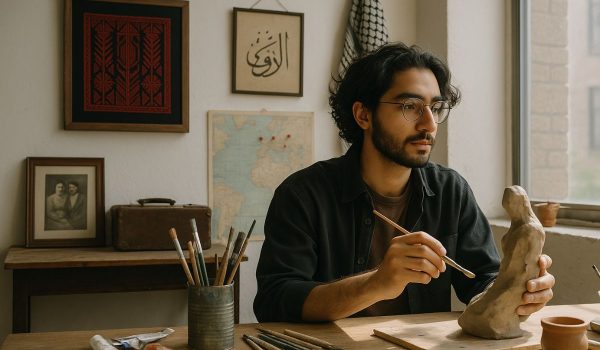Across cities, galleries, and screens, a new generation of diaspora artists is shifting how we think about identity. These artists are not confined by geography or traditional labels. Instead, they carry layered experiences shaped by migration, memory, resistance, and belonging.
For Palestinian artists in the diaspora, art becomes a space for dialogue and healing. It’s a way to hold onto the past while shaping the future. Through painting, poetry, music, photography, and performance, these creators are challenging narrow definitions of identity and speaking across borders.
What This Article Covers
This article explores how diaspora artists are reshaping identity through creative work rooted in personal and collective stories. It highlights the emotional weight of displacement, the strength found in cultural connection, and the ways art opens doors for conversation, visibility, and self-expression.
You’ll learn how art reflects lived experience, how it helps bridge generations, and why it matters so much in the ongoing story of Palestine and other communities shaped by exile.
Art as a Language of Belonging
For many diaspora artists, art is a second language. It helps express the complexity of living between places, of feeling both connected and apart. It makes space for all the contradictions—missing a homeland you’ve never seen, feeling loyalty to two places, or not fully fitting in anywhere.
These artists use color, texture, rhythm, and story to hold those emotions. A piece might reflect joy and grief in the same breath. A line of poetry might carry both pride and longing. Through these works, artists invite others to see the world through their lens.
That sense of belonging—often denied in other spaces—finds its way into the gallery, the stage, or the screen. It says, “This is who I am. This is where I come from. This is how I make sense of it.”
Identity Beyond Borders
Diaspora artists often challenge the idea that identity must be tied to one place, one flag, or one definition. Their work blends cultures, languages, and symbols. It pulls from tradition but is not limited by it.
A painting might combine Arabic calligraphy with modern street art. A film might move between English, Arabic, and French without translation. A dance performance might mix folkloric steps with hip hop. These choices reflect how identity moves and changes with time and distance.
Rather than asking, “Where are you from?” the work invites a deeper question: “What do you carry with you?” The answer is often a mix of history, family, dreams, and everyday struggle.
Art as Resistance
In the context of Palestine, art has always been more than decoration. It is a tool of resistance, remembrance, and refusal to be erased. For artists in the diaspora, this role becomes even more powerful.
When mainstream media distorts or ignores Palestinian voices, artists respond with their own images and stories. They create work that resists occupation, displacement, and silence. A photograph of a grandmother’s hands, a mural of a village long destroyed, a poem about checkpoint delays—all become acts of witness.
This resistance is not always loud. Sometimes it’s quiet and personal. But it still pushes back against erasure. It still says, “We are here. We remember. We imagine something different.”
Passing Stories Between Generations
One of the most beautiful things about diaspora art is how it connects generations. Children of exiles may not have lived through war or forced displacement, but they carry the stories. They grow up with memories told at the dinner table, in lullabies, in family rituals.
Artists in the second or third generation often use their work to process these inherited stories. They reinterpret them through their own experiences, making them current and personal.
This helps keep cultural memory alive. It also helps younger people understand that they are part of something bigger. They are not alone in their questions or their longing.
Art becomes a bridge—not only between cultures but between grandparents and grandchildren, past and present, memory and future.
Everyday Materials, Global Conversations
Many diaspora artists work with whatever is available—paper scraps, digital tools, recycled materials, public walls. The choice of medium often reflects accessibility and intention. It also reminds us that meaningful art doesn’t always come from formal training or big institutions.
An installation made with olive oil cans or embroidery patterns can speak volumes. A short film recorded on a phone can circulate across continents. A pop-up show in a community center can spark conversation that lasts for years.
These small moments of creation ripple out. They connect people in different cities, time zones, and life experiences. They show that art doesn’t have to be polished to be powerful. It just has to be real.
Claiming Space Through Creativity
Diaspora artists often face the challenge of visibility. Their work might not fit into neat categories. It may be seen as too political, too emotional, or too unfamiliar. But that tension is also where the power lies.
By claiming space through their creativity, these artists challenge who gets to be seen and heard. They reshape conversations about culture, identity, and community. They remind us that being between worlds can be a source of strength—not confusion.
In this way, every exhibition, performance, or self-published zine becomes an act of self-definition. It creates room for more stories, more voices, and more ways of being.
Why This Work Matters
When diaspora artists tell their stories, they do more than reflect reality—they reshape it. They help communities heal, connect, and imagine new futures. They remind us that identity is not fixed. It’s layered, living, and full of possibility.
Through art, these creators build a world where complexity is welcomed and shared. Where silence is replaced by song. Where heritage is not just remembered, but transformed.
Their work invites all of us to look closer, listen more deeply, and rethink what it means to belong.

